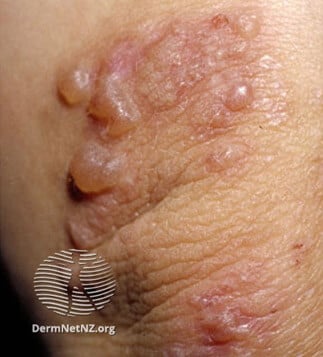Let’s not forget about our friends with Dermatitis Herpetiformis
 The Little Sister to Celiac Disease – Symptoms & Treatment
The Little Sister to Celiac Disease – Symptoms & Treatment
- breakinglatest.news/health 1
Dermatitis herpetiformis (DH) is a disease consisting of irritation of the skin due to the onset of numerous bubbles and blisters which cause an intense itching sensation.
DH is sometimes referred to as Duhring’s dermatitis herpetiformis in honor of the doctor who discovered and described it for the first time in 1884. Only in 1960 was the close correlation with celiac disease identified.
Sufferers of DH definitely have celiac disease, but few celiacs manifest the condition. It is defined as celiac disease of the skin.
Rather rare in children and the elderly, this pathology is more frequent in adults and young people.
Despite its name, DH is not related to any form of herpes, but refers to the appearance of blisters, bubbles and scabs, reminiscent of the typical marks left by herpes. DH is also not related to seborrheic dermatitis, atopic dermatitis or nummular eczema. It is a chronic condition that recurs in alternating cycles.
A genetic dysfunction prevents the immune system from recognizing some structures as the body’s own. In celiac disease, there is an attack on the intestinal mucosa.
In DH, the attack affects the epidermis when antibodies damage skin cells. This pathology can also be linked to other autoimmune diseases including pernicious anemia, type 1 diabetes mellitus and thyroid malfunction.
The onset of DH typically occurs between the ages of 20 and 30. If the pathology is not promptly treated, the skin lesions can remain for long periods or disappear and recur periodically.
The areas of the body most affected are the knees, elbows, shoulders and lumbar region, but in some cases, DH can affect the face, hands and scalp. Symptoms include
- blisters grouped in various areas of the body
- erythematous spots
- bubbles then replaced by crusts
- redness
- severe itching
- burning
- altered pigmentation of the skin.
DH is a very itchy rash and the consequent rubbing can be the cause of further bacterial super-infections.
DH is sometimes confused with other types of skin lesion that have similar symptoms. A skin biopsy tests for the presence of antibodies on a small part of skin tissue not directly affected by the rash.
People with DH may or may not exhibit the digestive symptoms associated with celiac disease or damage to the lining of the small intestine. Once diagnosed, patients must adopt a strict gluten-free diet, for life.
Treatment can take the form of sulfapyridine and sulfamethoxypyridazine, causing symptoms to regress within a few days.
Dapsone, a drug specifically designed for dermatitis herpetiformis, can also help to resolve the rash, while the patient eliminates gluten from their diet. Side effects of dapsone can include vomiting, diarrhea and loss of appetite..
In conclusion, dermatitis herpetiformis is a serious condition that requires timely and adequate treatment. Following a gluten-free diet and taking medications prescribed by the doctor can help control symptoms and improve the patient’s quality of life. With the right care, many patients with dermatitis herpetiformis are able to manage their condition and live active lives.
See also Celiac Disease Has a Little Sister – Dermatitis Herpetiformis












